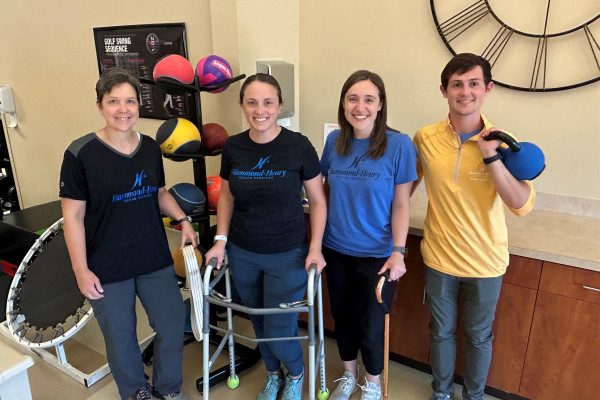Blog
Holistic Healing: An Inside Look at Physical Therapy

At Hammond-Henry Hospital, our commitment to your health doesn’t end with diagnosis and treatment. Recovery and long-term wellness are equally important parts of your journey—and that’s where speech, occupational, and physical therapies come in. These specialized services support patients of all ages, helping them rebuild strength, relearn skills, and regain independence after illness, injury, or surgery.
Learn more below about the therapies we offer in the comfort of your own home.
Speech Therapy: Finding Your Voice Again
Whether recovering from a stroke, managing a neurological condition, or helping a child with developmental delays, speech therapy (also called speech-language pathology) plays a critical role. Our licensed speech-language pathologists help patients:
- Improve speech clarity and pronunciation
- Strengthen communication skills
- Overcome cognitive challenges like memory or problem-solving
- Safely manage swallowing disorders
Effective communication is crucial to quality of life, and speech therapy enables patients to connect with others and express themselves with confidence.
Occupational Therapy: Building Daily Living Skills
Occupational therapy (OT) focuses on empowering patients to perform daily activities safely and independently. From buttoning a shirt to using a computer, these tasks are essential for leading a fulfilling life. Occupational therapists work with patients to:
- Relearn fine motor skills
- Adapt homes and routines for safety and ease
- Improve coordination and sensory processing
- Use assistive devices when needed
For patients recovering from surgery, living with chronic conditions, or navigating developmental challenges, OT offers personalized strategies to overcome barriers.
Physical Therapy: Restoring Movement and Strength
Physical therapy (PT) helps patients reduce pain, restore mobility, and prevent further injury. Whether it’s walking after a joint replacement, regaining balance after a fall, or easing back pain, PT focuses on physical function and long-term recovery. Through one-on-one sessions and tailored exercise programs, patients can safely manage their pain.
Our expert physical therapists assist patients with:
- Sports injuries, such as sprains and strains
- Pain management
- Arthritis
- Postpartum
- Balance, strength, and mobility
- Strokes
- Degeneration
- Inflammation
- Postural issues
- Joint pain
- Muscle pain
- Nerve pain
- Stiffness and tightness
- Weakness
- Hypermobility
- Hypomobility
- Poor balance
- Vertigo
When Should You See a Physical Therapist?
You don’t need to wait for severe pain, loss of mobility, or weakness which limits your ability to do the things you enjoy. Talk to a physical therapist if you:
- Are recovering from an injury or surgery
- Experience recurring aches or stiffness
- Have trouble walking, standing, or doing everyday tasks
- Want to stay active and strong as you age
Assessing a New Patient’s Pain, Mobility, and Goals
When meeting with a new patient, we thoroughly review their medical history and discuss the type of pain they are experiencing. We discuss their physical limitations and how that impacts their ability to perform both simple and complex tasks. From there, we analyze and assess how they move in three planes of motion. The analysis consists of:
- Checking for compensatory movement patterns.
- Determining if the patient moves too little or too much in each joint, both locally and globally.
- Measuring range of motion, strength, balance, and swelling.
After a thorough verbal evaluation, we then perform an objective examination to determine the source of their ailments, rather than focusing solely on the symptoms. This helps us determine and develop a plan of care for patients to achieve their goals and become as independent as possible.
How Often are Physical Therapy Sessions?
The frequency of physical therapy sessions per week varies based on each patient’s diagnosis, the severity of their symptoms and limitations, and how well they follow their therapy program at home. A post-operative patient may require three times per week for a few weeks before their sessions start tapering. Other patients require 1-2 sessions per week, and others may need only 1-2 sessions per month. Some patients find relief after just one visit.
What are the Benefits of Physical Therapy?
Here’s why physical therapy can make a real difference in your health and daily life:
It's Not “Just Exercise”—It’s Targeted Treatment
Every stretch, movement, or hands-on technique your physical therapist recommends is designed for your condition, your body, and your goals.
Physical therapists use:
- Gentle techniques to reduce pain and stiffness
- Strength-building exercises to prevent future injuries
- Balance and coordination training to keep you steady on your feet
It Helps You Heal Naturally
Many people turn to physical therapy to:
- Avoid surgery
- Reduce or eliminate the need for pain medications
- Recover faster after injury or surgery
By improving how your body moves and functions, physical therapy supports your natural healing process—without invasive procedures or long-term drug use.
Your Treatment Plan Is Made Just for You
No two people are the same, and physical therapists get that. Your physical therapy plan is tailored to:
- Your condition (from joint pain and weakness back to post-surgical recovery)
- Your lifestyle (whether you're an athlete or want to walk without pain)
- Your goals (like getting back to work, sports, or daily activities)
This individualized care makes recovery faster and more meaningful. Our goal is to put you at ease as you work toward your goals. Reach out to 309.944.9150 to schedule a free screen or speak directly with one of our physical therapists.
